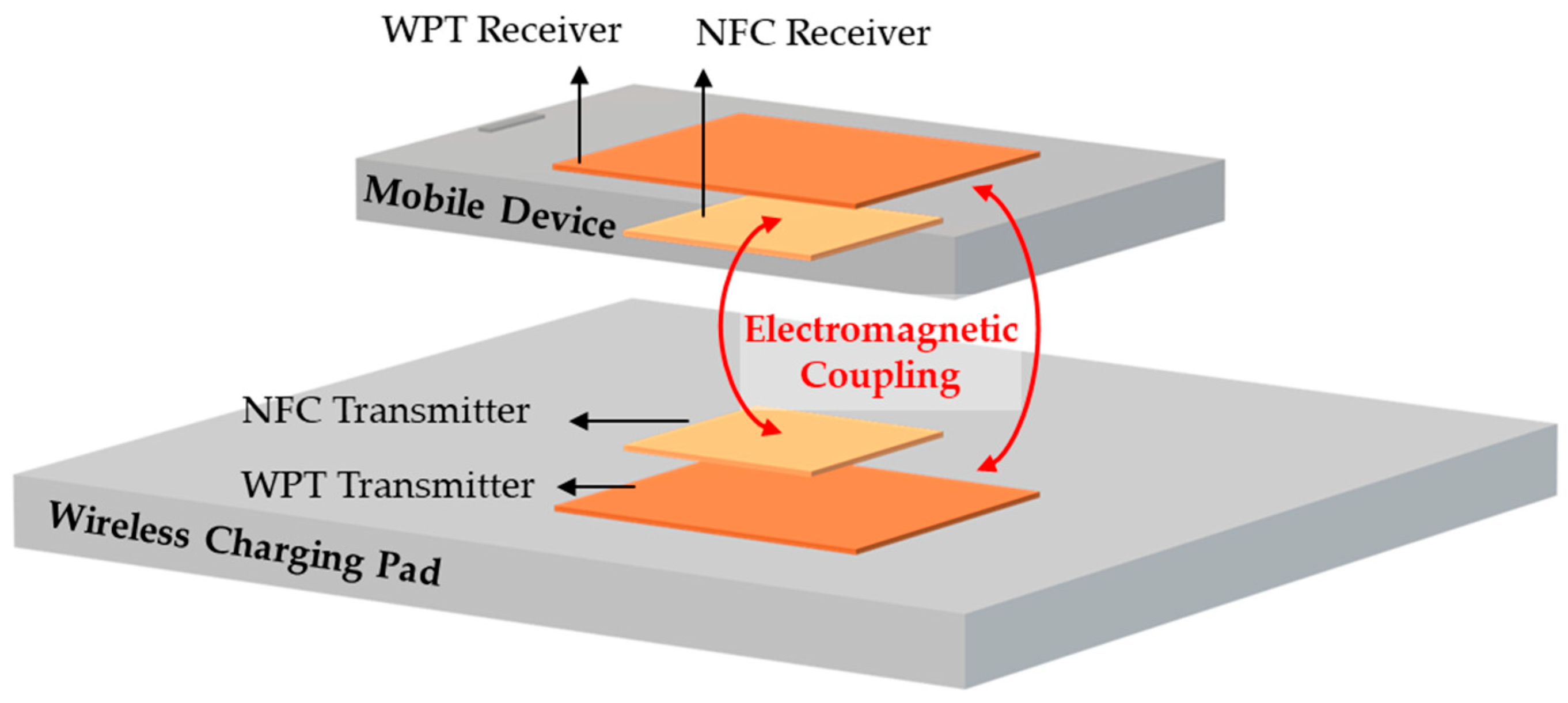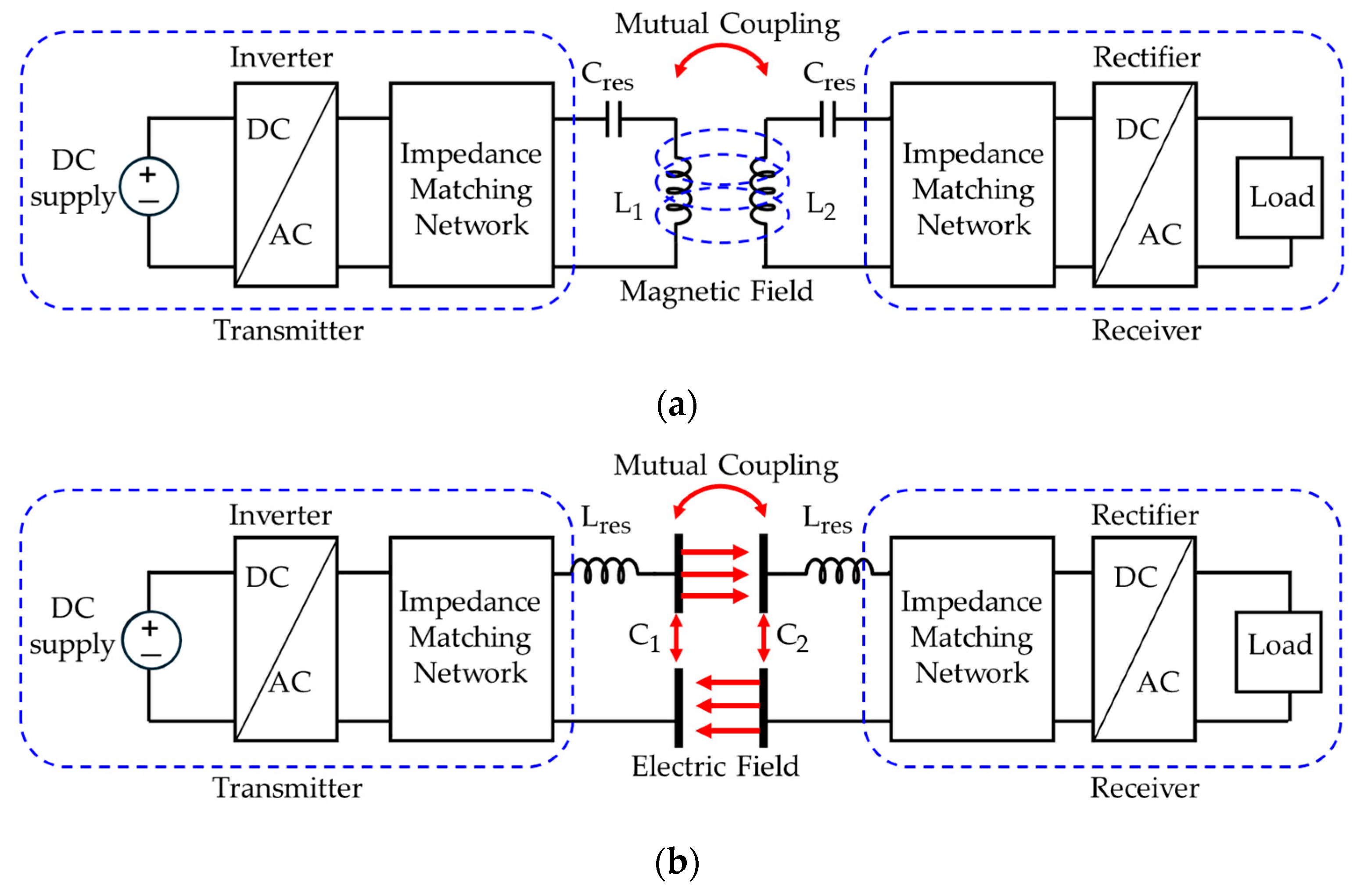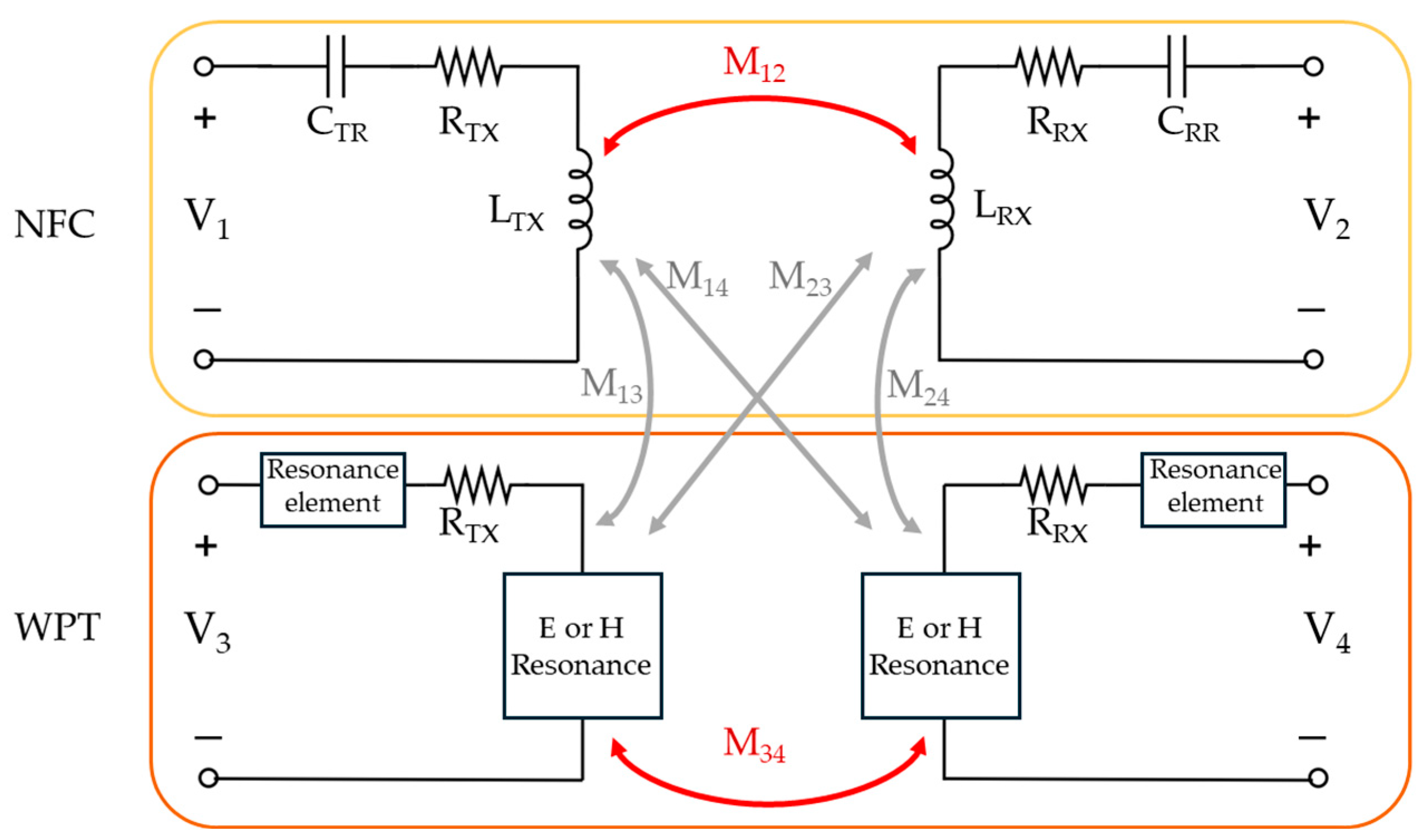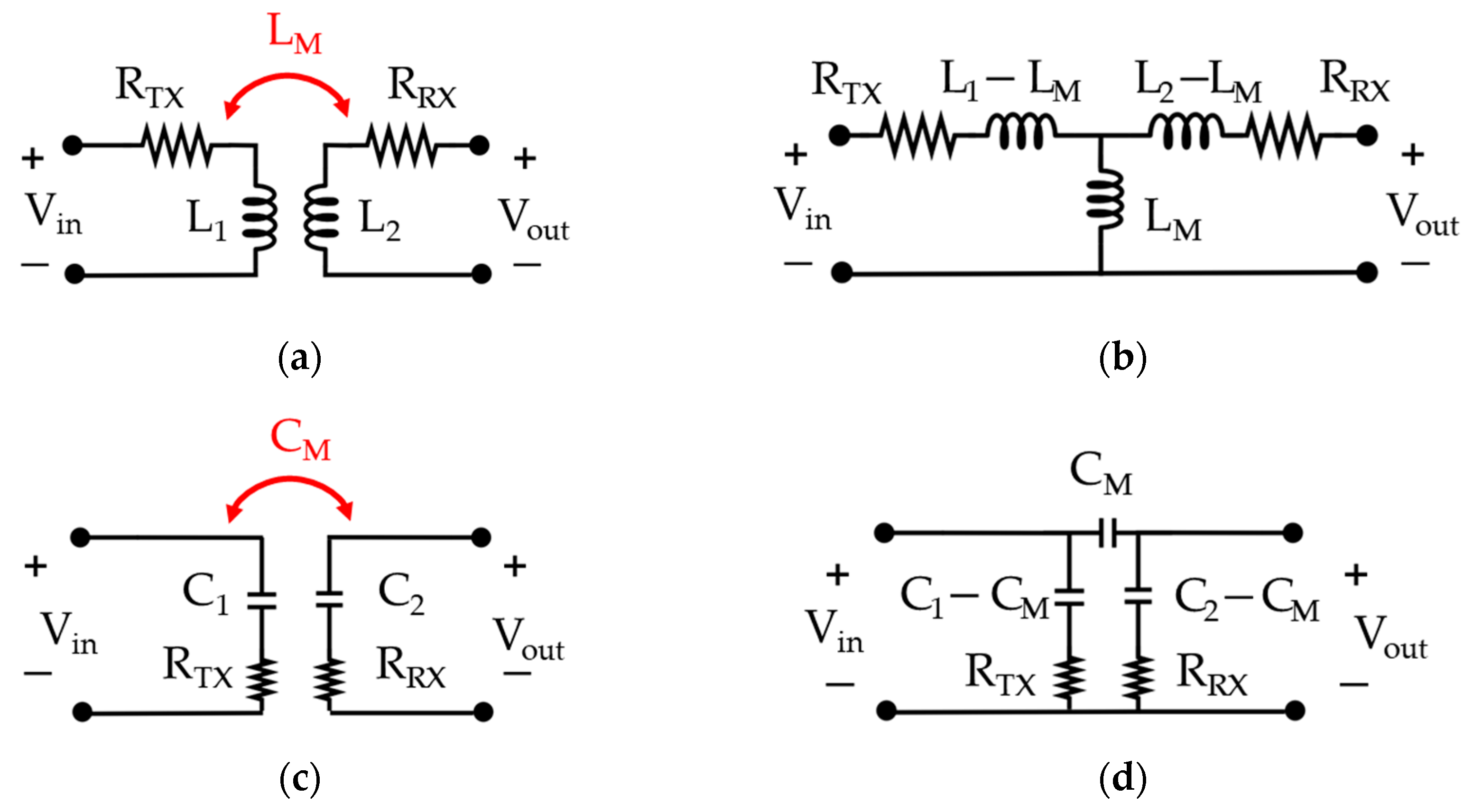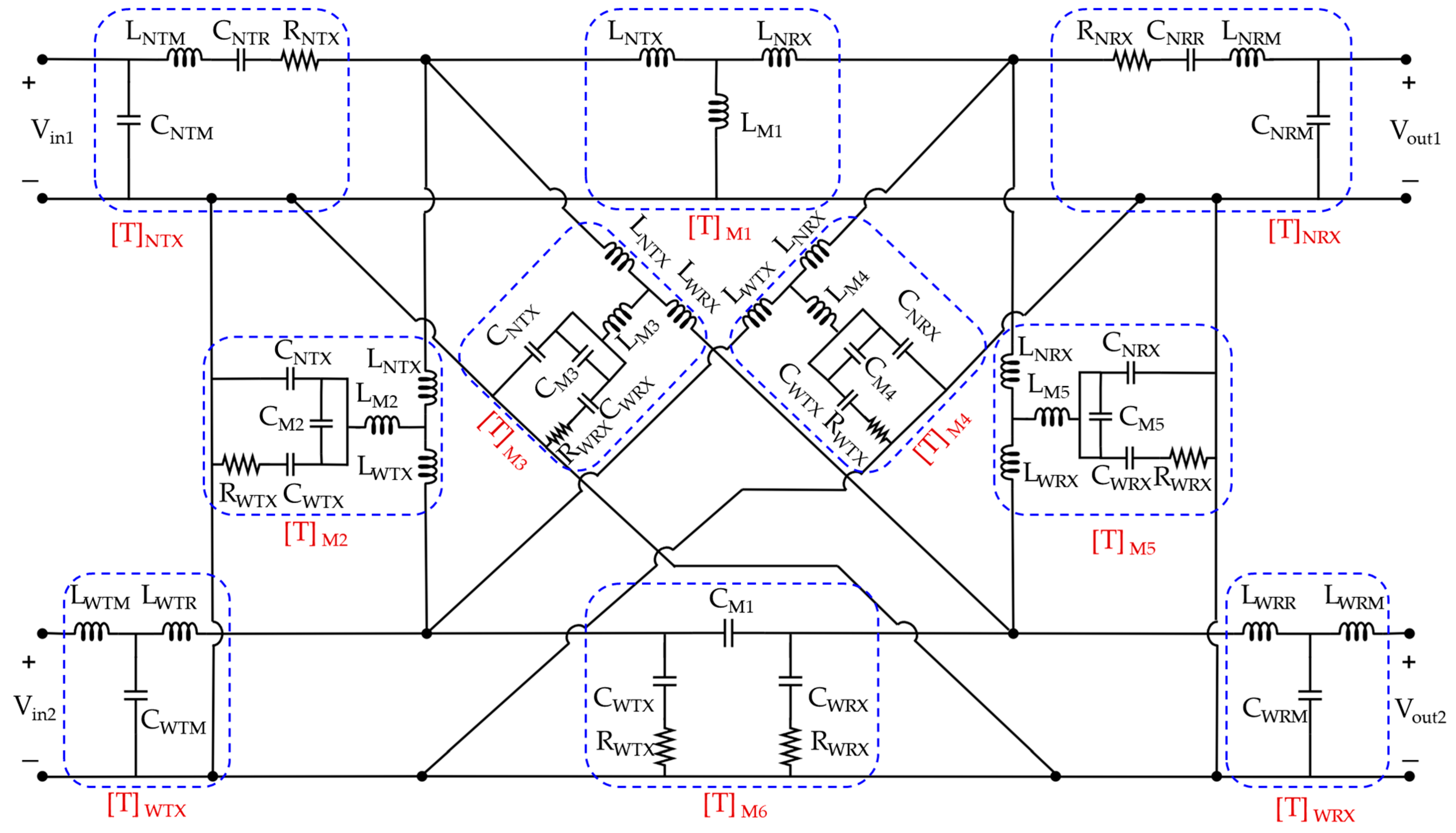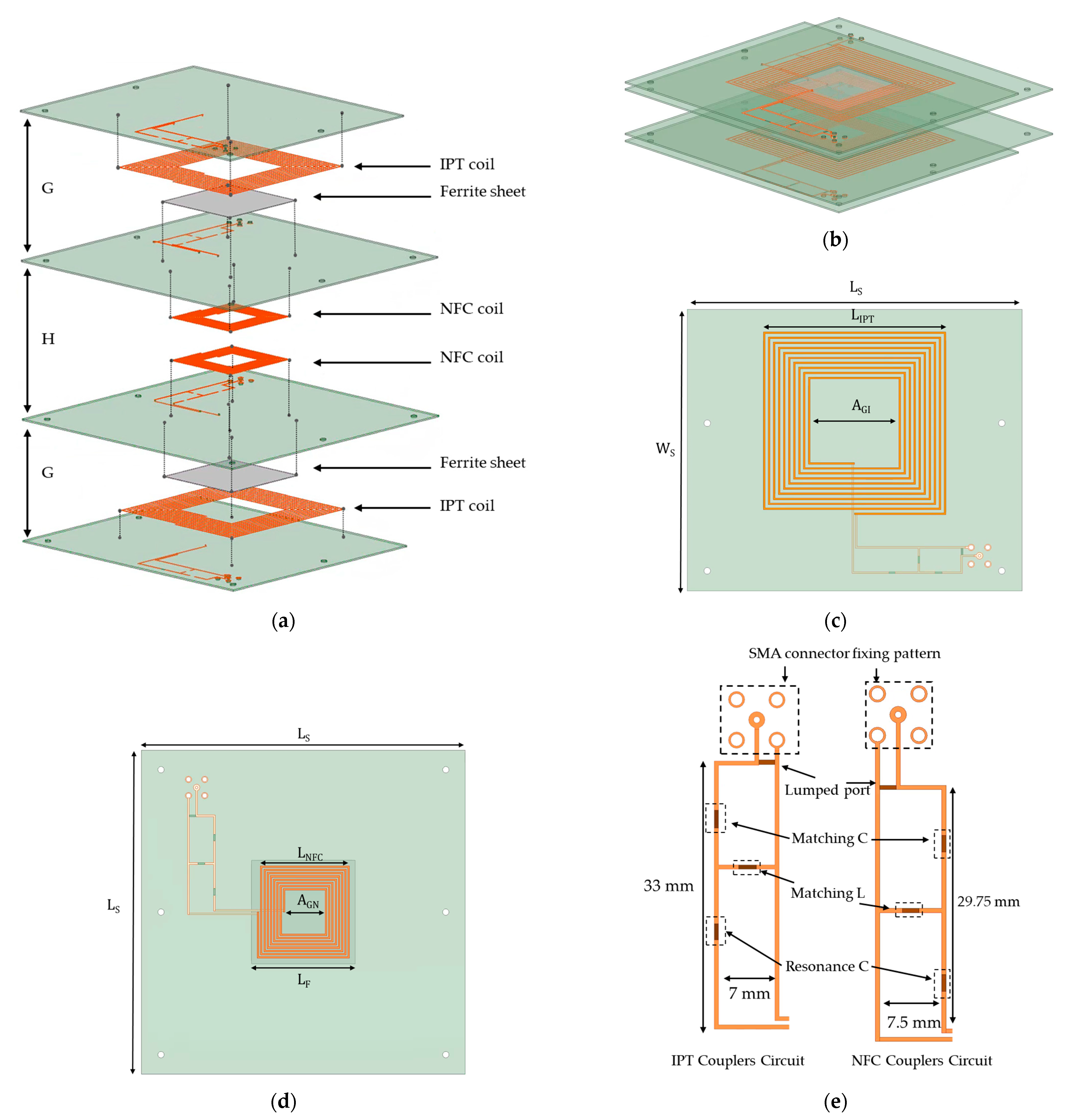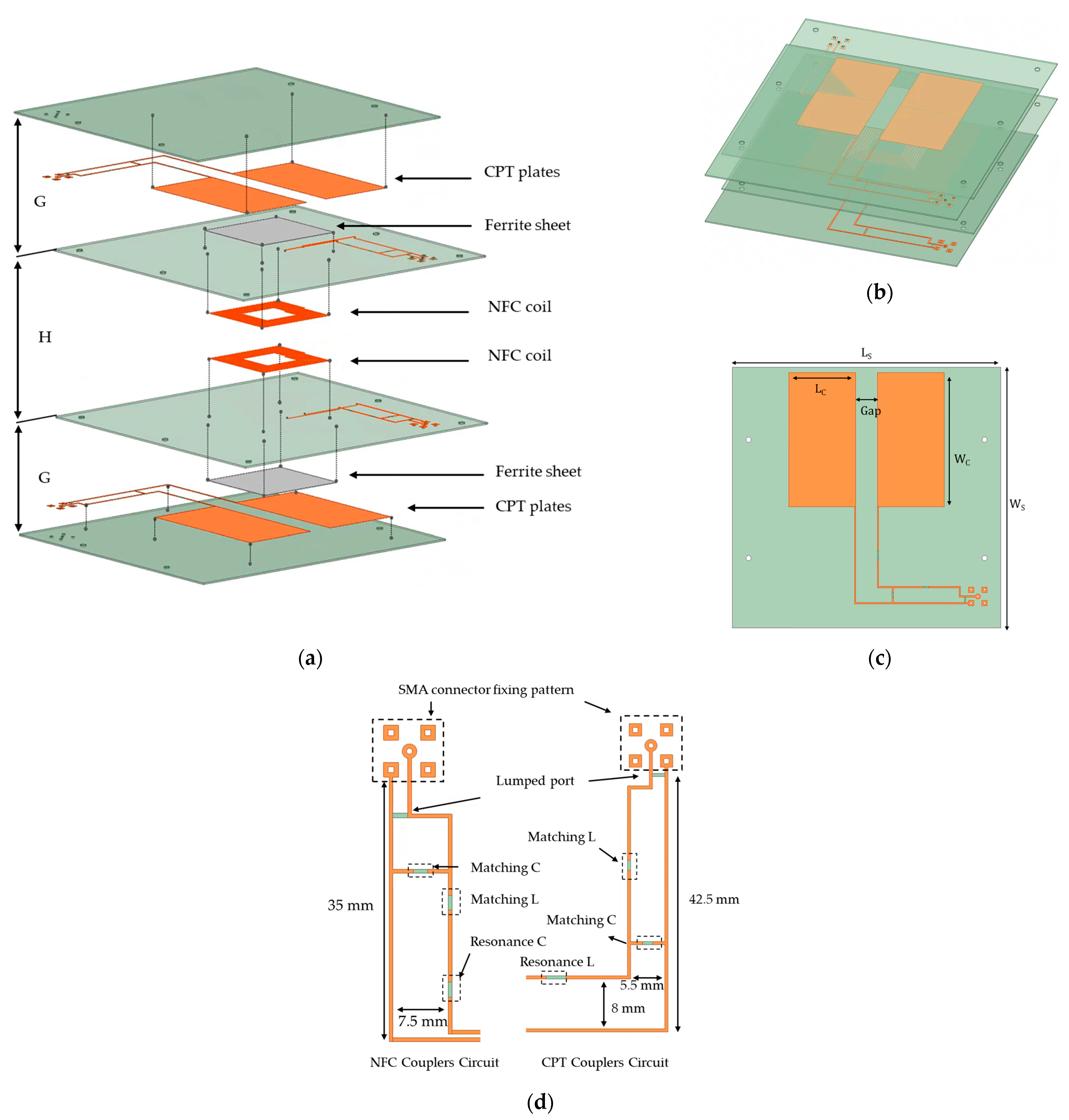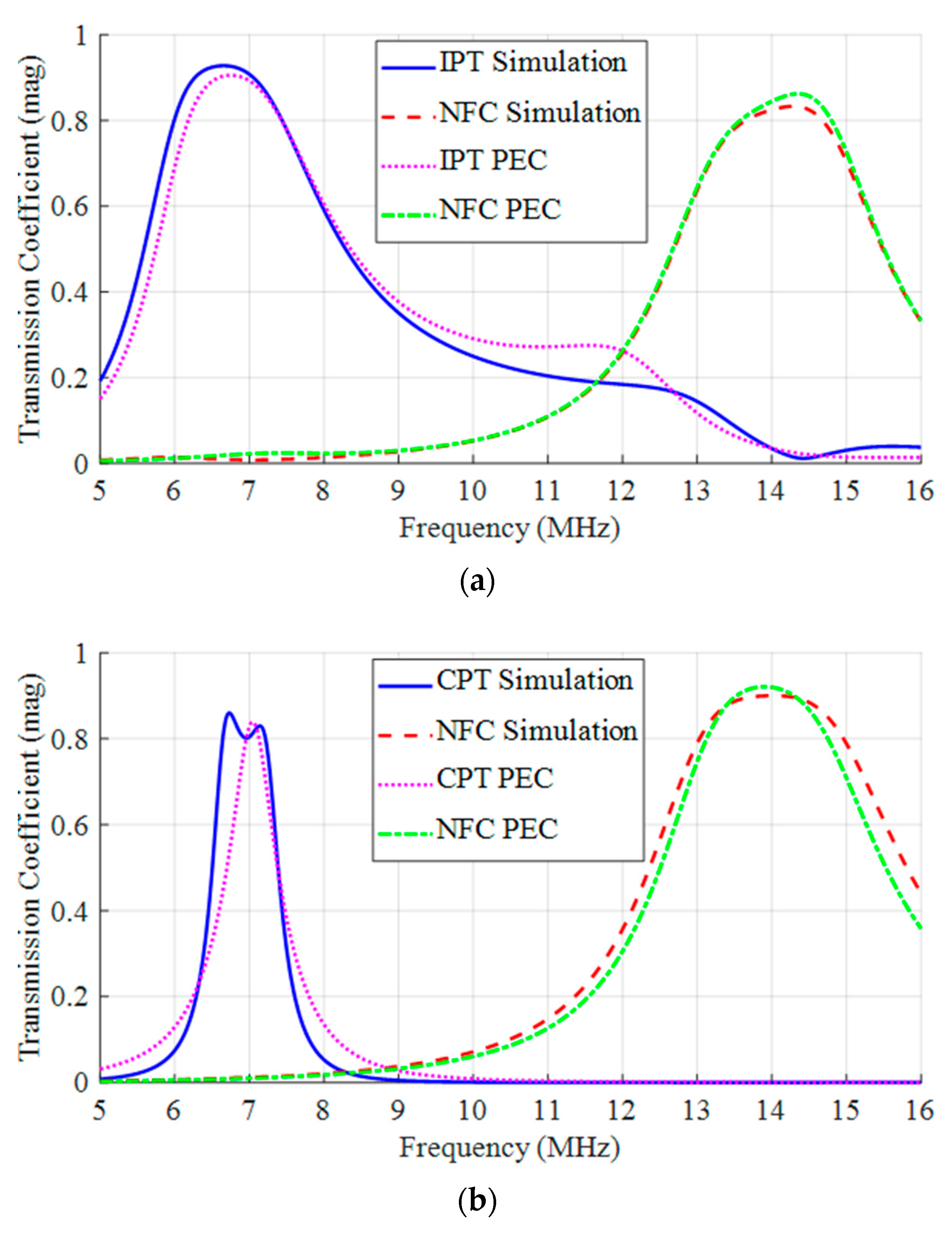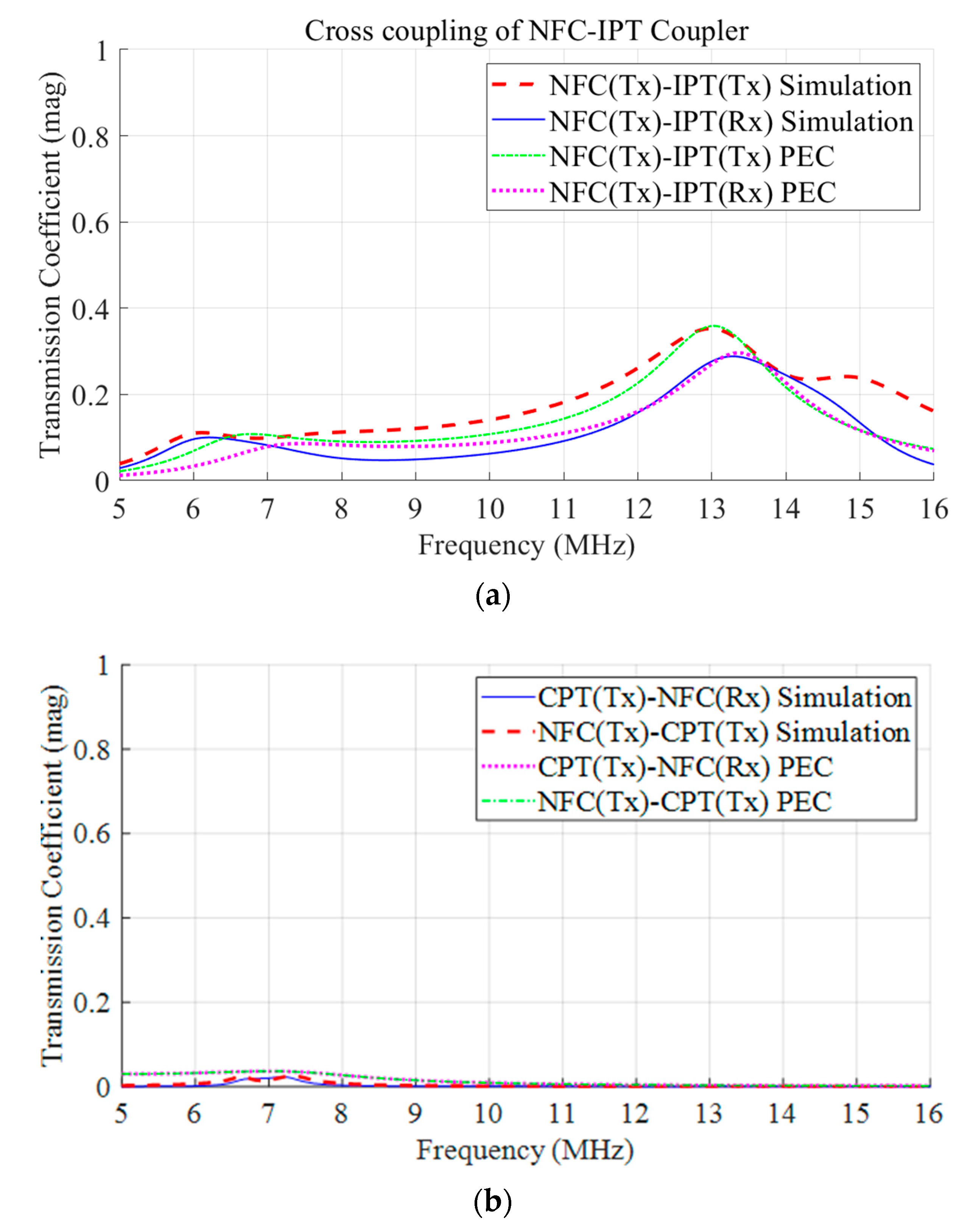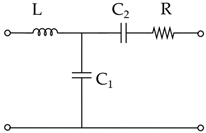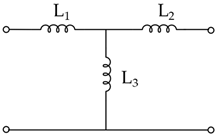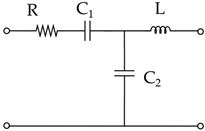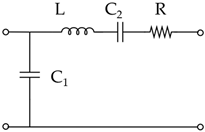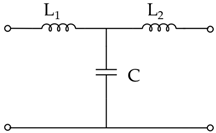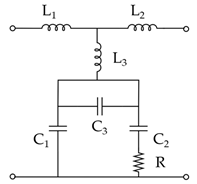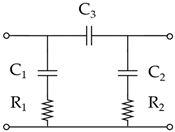2.1. Theoretical Deisgn Method of PEC Circuit
The configurations of the inductive power transfer (IPT) system, based on magnetic field coupling, and the capacitive power transfer (CPT) system, based on electric field coupling, are shown in
Figure 2. In
Figure 2a, an AC voltage source generates magnetic coupling between two coils, enabling power transfer in the IPT system. In contrast, in
Figure 2b, an AC voltage source generates electric coupling between four metal plates, facilitating power transfer in the CPT system.
For these couplers, precise design of the impedance matching circuits for both the transmitter and receiver is essential to maximize coupling at the resonant frequency. In general, the term ‘coupler’ refers to a structure that includes the impedance matching circuit, resonant elements, and primary coupling components, such as coils or metal plates. Accurate equivalent circuit design and analysis at the coupler level are crucial, as they enable the quantification of interference and losses in system design through equivalent circuit parameters.
Therefore, a PEC for a four-port network incorporating loss resistance is designed for the NFC–IPT and NFC–CPT hybrid coupler model, and its S-parameters are calculated. Furthermore, previous studies have demonstrated that theoretical analysis based on the equivalent circuit model and electromagnetic simulation results exhibit high agreement with experimental validation [
22]. Based on these findings, this study focuses on validating the PEC-based theoretical analysis by comparing it with electromagnetic simulation results obtained using ANSYS HFSS 2021R2, excluding experimental verification.
Figure 3 illustrates the link structure of the four-port coupler combining NFC and WPT. The WPT system can be implemented using either IPT or CPT and follows the MIMO WPT link principle [
23]. In the NFC coupler, V1 and V3 represent the source voltages of NFC and WPT, respectively, while V2 and V4 correspond to the load voltages.
Since the four-port network has a total of six mutual terms, it consists of two main coupling terms and four cross-coupling terms. The main coupling in the NFC coupler is denoted as M12, while that in the WPT coupler is represented as M34. When the WPT system coupled with NFC operates in CPT mode, the resonant fields differ, meaning the cross-coupling terms M13, M14, M23, and M24 can be assumed to be nearly zero. Conversely, when the IPT coupler is applied, magnetic coupling occurs, potentially leading to cross-coupling with the NFC coupler. The equivalent circuit model proposed in this study explicitly represents this coupling effect.
In this study, the PEC of each coupler is theoretically designed and compared with 3D full-wave simulation results. Since the NFC and WPT couplers are combined, a 4 × 4 transmission matrix is derived for four-port network analysis, and the overall S-parameters are calculated. The PEC is structured by segmenting the PCN and defining the transmission matrix for each segment. By converting and multiplying the transmission matrices of each segment into S-parameters, the overall S-parameters of the coupler can be obtained.
The structure of the PEC matrix varies depending on the coupling field and the matching circuit configuration of the coupler. In this study, the PEC matrix is classified into two types. Since IPT operates via magnetic coupling, the equivalent circuit of
Figure 4a can be transformed into a T-model, as shown in
Figure 4b, incorporating mutual terms. Meanwhile, the four-plate CPT coupler utilizes electric field coupling, and its equivalent circuit can be transformed from the structure in
Figure 4c into a pi-model, as illustrated in
Figure 4d. Additionally, all PEC models incorporate coupler loss resistance to ensure high accuracy in comparison with simulation results.
In the equivalent circuits of the two couplers proposed in this study, the PCNs exhibit several common structural patterns. Due to the redundancy in the transmission matrix formulations across all circuit networks, different types of networks are classified. The PCNs of the couplers are categorized accordingly, allowing each to be substituted into the corresponding transmission matrix equation for calculation.
2.2. PEC Model of NFC–IPT
Figure 5 illustrates the four-port network equivalent circuit model combining NFC and IPT couplers. Since coupling occurs between coils, self-inductance and mutual inductance are represented using a T-model circuit. In the four-coil system, six mutual inductance components can be defined and are denoted as L
M1 to L
M6 in the equivalent circuit model. For example, the mutual inductance between the NFC transmitter and the IPT receiver is represented as L
M5.
The impedance matching circuits and resonant capacitors in the NFC transmitter and receiver, along with the inherent loss resistance of the coupler, are represented as [T]NTX and [T]NRX. The circuit network including the self-inductance and mutual inductance of the NFC transmitter and receiver is denoted as [T]M1. Similarly, the circuit network representing the self-inductance and mutual inductance in the coupling between the NFC transmitter and the IPT coupler is expressed as [T]M2.
The 4 × 4 S-parameters of the four-port network can be defined as a combination of 2 × 2 matrices obtained by decomposing
Figure 5 into two-port network representations. The S-parameters of the PCNs calculated and multiplied to define the S-parameters of the two-port network as follows.
The parameters illustrated in
Figure 5 are summarized in
Table 1. To accurately represent self-inductance in the T-model circuit, it must be considered as the value obtained after subtracting mutual inductance, as shown in
Figure 4b. In a four-port network, each self-inductance accounts for three mutual inductances.
The PCNs of the NFC–IPT coupled system can be classified into Type A, Type B, and Type C, as summarized in
Table 2. Each classification corresponds to a specific circuit configuration, allowing for a systematic analysis of the coupler’s PCN.
For an N-port network’s T-model equivalent circuit, self-inductance (L
C) and mutual inductance (M
1j) can be conceptually defined as shown in Equation (3). The self-inductance values listed in the table represent ideal values that do not account for the mutual inductance between NFC and IPT. This relationship is incorporated into the S-parameter calculation process of the equivalent circuit model.
Using the transmission matrix conversion formulas for each circuit type in the table, the equation can be expressed as follows.
To convert the transmission matrix into S-parameters, ref. [
24] proposed a method to simplify the complex equations through substitution. By defining the elements of the above matrix as t, the components of the S-parameters can be organized as shown in
Table 3. Each term is derived from equations used for substitution, and the S-parameters can be obtained by referring to Equation (5) of the referenced study.
2.3. PEC Model of NFC–CPT
Figure 6 illustrates the four-port network equivalent circuit model combining NFC and CPT couplers. The detailed parameters are summarized in
Table 4. Since the NFC transmitter and receiver are coupled through coils, self-inductance and mutual inductance can be represented using a T-model circuit. However, when the NFC transmitter is coupled with the CPT transmitter or receiver, the interaction between coils and metal plates must be considered. The coupling strength between magnetic and electric field components is generally close to zero.
Therefore, in the equivalent circuit model, the matrices for the circuit networks corresponding to [T]M2 through [T]M5 are not explicitly defined but are calculated accordingly. Additionally, the CPT coupler’s self-capacitance, mutual capacitance, and coupler loss resistance are included in a separate network, denoted as [T]M6.
Similar to the NFC–IPT coupler, the 4 × 4 S-parameters can be derived by defining the S-parameters of the two-port networks as follows. While the equivalent circuit model and calculation equations remain the same as those for the NFC–IPT coupler, it is important to note that the numbering of the coupled networks differs.
The PCNs of the NFC and CPT combined coupler can be classified into Type D, Type E, Type F, and Type G, as shown in
Table 5. Each classification corresponds to a specific circuit configuration, allowing for an analysis of the coupler’s PCN. Among them, Type F, which is an uncommon configuration, can be calculated as the sum of Type B and Type G. Type F represents a circuit designed to simultaneously express self-inductance and self-capacitance in the coupling between coils and metal plates. This circuit can be referenced in studies on hybrid wireless power transfer couplers that combine IPT and CPT designs [
25].
Since the coupler’s loss resistance of the coil has already been considered in the impedance matching circuit network, only the loss resistance of the CPT coupler is included in Type F. Therefore, the self-capacitance and loss resistance, which are expressed in series, are represented only on the CPT side.
The transmission matrices of the partitioned circuit networks for each Type in
Table 5 are as follows.
Similar to the NFC–IPT coupler, the S-parameters of the partitioned circuit in the NFC–CPT coupler are shown in
Table 6.
